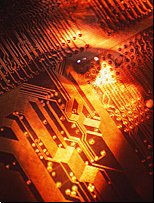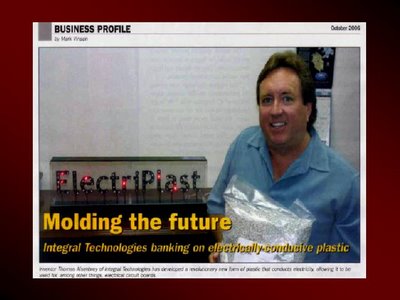ElectriPlast: The Journey Continues

Beginning
with the End
in Mind
By D. W.
Special to the ElectriPlast Blog
[Editor's Note: The epic poem attributed to Homer recounts the long wandering voyage of Odysseus and his many changes of fortune during the journey. The following is a longtime shareholder’s perspective on the long journey of Integral Technologies, its search for a product and how it found itself with the invention of ElectriPlast.]
A company in search of itself
Let me emphatically state the obvious: Integral Technologies is a company with an uncertain past. It has a history of missed deadlines, mounting debt and lawsuits from previous partners and former employees. While Integral has met the legal challenges head on and won each case, these issues have impeded its journey to success.
Along the way, Integral has hobbled along on "crutches" supplied by venture capitalists such as Wellington Management, Swartz Private Equity, angel investors and private investors. Their assistance didn't always come cheaply, but they enabled Integral to remain solvent while it pursued its business plan. Although no startup likes dilution, it is quite remarkable for an OTCBB stock to have roughly 45 million shares outstanding when many other companies have been diluted by hundreds of millions of shares. Overcoming such staggering numbers of shares issued is never easy; however, one strategy is the “reverse split,” which is almost NEVER a positive event for shareholders. CEO Bill Robinson knows this and has resisted every temptation to place Integral Technologies in a dilutive position.
Yeah, but will it sell
Some have ridiculed recent license agreements with Heatron and Jasper Rubber Products as being of infinitesimal value. However, many with whom I am acquainted believe those agreements are precursors to real revenue with household name companies. Moreover, I believe history will actually record those agreements as two of the shrewdest moves Integral has ever made. One could make the argument that only one contract with any one of the “majors” has the potential to put us on the road to profitability very quickly.
Integral Technologies has filed 111 ElectriPlast-based patents, each of which supports up to 1500 consumer items as diverse as molding, medical and military applications. These are multibillion dollar industries. How large a slice of the pie do we need in any of those market areas to become instantly profitable and make our seemingly interminable wait worthwhile? So, the question is not whether or not our technology is disruptive (that is a given for those who choose to see); the question has always been: Will Integral capitalize on it?
I’m betting they will because they are free thinkers and paradigm busters. Bill Robinson, Bill Ince and Tom Aisenbrey are radicals who don’t see problems without seeing solutions. In the world of conductive polymers, they are revolutionaries who are well before their time.
That’s what maps are for
Stephen Covey is world-renowned for his book, The Seven Habits of Highly Effective People. As the title implies, he lays out the fundamentals of leadership outlined in his “Seven Habits.” The second of his seven habits is, “Begin with the End in Mind,” the basic premise of which is that all things are created twice – first mentally, then physically. With the advent of ElectriPlast, Integral has been on a 4-year journey to refine the mental creation – the plan, design and layout of what they want to do and where they want to go. That time spent in preparation is unquestionably leading to the physical creation, the part that you see unfolding before your very eyes. Some people focus on the miscues of this refining process and point to the principals as little more than misguided miscreants. Although not completely understood, others see their actions as necessary, purposeful and deliberate steps in the journey. Very few, however, have the vision or the ability to take the blank canvas and imagine, see, and create the picture that is ElectriPlast. The Integral management team has that ability.
The answers are in the questions
The following Q & A is offered for those who have expressed uninformed cynicism about Integral Technologies and its intellectual property (IP).
- Q. When ElectriPlast was little more than a startling epiphany, how did company officers handle product publicity? Did they hawk this IP on TV or through Infomercials? A. No! They sought legal advice of one of the nation’s premier intellectual property firms – Preston Gates Ellis.
- Q. While Tom Aisenbrey invented ElectriPlast patents at an incredible rate, uncovering many unique and different applications, what was Bill Robinson doing? A. He retained George O. Sailes, the nation’s premier patent attorney (who had filed many IBM patents), to protect Integral’s IP.
- Q. Before a single dollar of ElectriPlast revenue was produced, what did Integral do? A. The company consulted with some of the most brilliant business strategists in the country – the QuanStar Group – to ensure they were following the right path and doing everything possible to ensure they “did it right” in taking this revolutionary product to market.
- Q. Once word surfaced, first in whispers, then in shouts, that we really had something – that there really was something to all of this conductive polymer talk, did Integral flood the market with press releases to artificially inflate the stock price? A. No! They worked diligently making contacts, developing a supply-chain infastructure, presenting their ideas, networking with the captains of industry – working a solid business plan.
What were they doing?
The Integral team was following Stephen Covey’s second of seven habits: Begin with the end in mind! And that, my friends, is what they’ve been doing these past four years. They began their journey knowing what the final outcome would be and which path would get us there.
Those who have spoken with Bill Robinson, or who have observed him in action know that he exudes confidence. Confidence that the plan is coming together! Confidence that our ElectriPlast IP will be protected! Confidence that it will one day be a household name! Confidence that those investors who stayed the course will not be disappointed! His every action is that of one who believes he’s already arrived: He has the end in mind. Integral has created the path. Can you see it?
The bottom line is that a win will make all the negatives disappear on the very same day that a victory settlement is announced. It all goes away. This opportunity is huge and awe inspiring. A few of us here understand the dynamic that is occurring. That is the sole reason why I am here and have remained so for several years.
We are near the end of this long journey. I will be there to help our visionary founders celebrate.
Will you be there?










